Published
on 1
May 2012
|
All rights reserved.
|
|
|
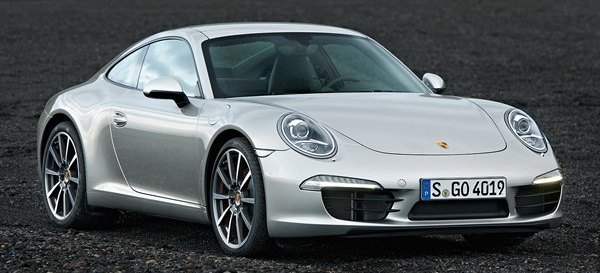 |
|
The
latest 911 takes another giant leap like that of 996...
|
|
People say if there
is
only one sports car you must drive in a lifetime, it will be the 911.
Since 1963, the iconic Porsche has always been the standard of
daily-use sports cars. It is not necessarily the fastest or the most
beautiful, but few rivals can combine driving thrills and everyday
usability like it. Even fewer can be as characterful. This unique
character comes from the rear-engined layout and six-cylinder boxer
engine, which dictate its shape, its sound and the way it corners.
Evolution or
Revolution?
For nearly 50 years, Weissach strived to preserve this character while
meeting new requirements for performance, drivability, comfort and
safety. Most of the time it took an evolutionary approach – such as the
cases for the first 25 years and the outgoing 997. Sometimes it needed
a small mutation, such as 964
and 993, to keep it at the
forefront. There was only one time when the 911 ran out of potential
for further development and necessitated a full makeover. That was the 996. The 996 was the turning point of 911's
history. It introduced an all-new chassis, modern aerodynamics and a
water-cooled 24-valve engine so to wave goodbye to the classical era
and say hello to the new world. Its track record became the template
for the latest 991.
As early as 2007, Porsche realized that it could no longer continue the
evolutionary approach on the next 911. Audi R8 had shown it the
strongest ever threats, and the mightily quick Nissan GT-R was just
around the corner – having already set many eye-popping lap times at
Nurburgring. To maintain its leadership the 911 should take another
giant leap like the 996. Therefore, project 998 was kickstarted as a
clean-sheet development program. In order to deceive parts suppliers
who might leak information to its rivals, the project was renamed to
991 later on so to confuse with the next generation Boxster or Cayman.
This explains why the 991 breaks away from the tradition of using
incremental numbers for its code name.
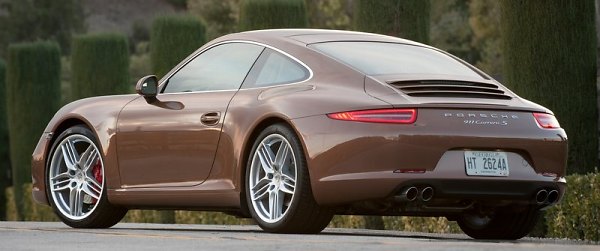 |
|
A
100mm longer wheelbase and wider front track improve handling.
|
|
Chassis and Body
The chassis of 991 is all-new. It has a more modern proportion, i.e.
faster windscreen and fastback angles, shorter overhangs, slightly
lower and a wheelbase boosted by 100 mm to 2450 mm – that is only the
third wheelbase extension in its entire history (the first and second
happened in 1969 and 1998 respectively). It also sports a wider front
track to improve handling (up 46 mm on Carrera and 52 mm on Carrera S).
Despite of the extra dimensions, the new car is 30-40 kg lighter than
the outgoing 997, thanks to an aluminum-steel hybrid construction.
Porsche did not follow Ferrari or Audi to employ
spaceframe chassis made entirely of aluminum, because that would have
thickened the pillars and door sills thus hamper cabin space and ease
of entry (remark: aluminum takes larger section than steel to achieve
the same stiffness). Instead, the 991 uses super-high-strength steel,
baron steel and multiphase steel at locations where stiffness matter
most, whereas aluminum is used for the floorpan, roof, door skins,
bonnet, engine lid, luggage compartment, front crash structure and rear
fenders. They comprise
45 percent of the body shell. Besides, the dashboard mounting beam is
made of magnesium. The new chassis is 20-25 percent torsionally stiffer
than the old one.
|
|
|
45
percent of the body is made of aluminum. Super-high-strength steel,
baron steel and multiphase steel are used at locations where stiffness
matter most.
|
|
The new shape is the work of chief designer Michael Mauer.
Since
joining Porsche in 2004, this is the first time Mauer is given the
necessary freedom
to reshape the iconic Porsche. The new car has a sleeker, more modern
profile, yet it still looks every bit a true 911. Its faster rear
window leads to a higher tail, which can no longer be called
"ducktail". Details at the rear end is further refined. The slim
taillights and the way they meet the recessed rear spoiler and rear
quarter panels show high level of finishing. Overall, the 991 has a
polished, high-quality feel for which its predecessors could only
dream. This distances it from cheaper rivals like Lotus and Nissan.
The new body retains a drag coefficient of 0.29, but aerodynamic lift
has been reduced to nearly zero, thanks in part to the raised tail. The
rear spoiler no longer sits between the taillights, thus it can get
wider and more effective. As
before, it normally recesses onto the tail and rises at
higher speed.
|
|
|
Michael
Mauer is finally given the necessary freedom to reshape the iconic
Porsche. The result is a sleeker, more modern proportion.
|
|
Suspension,
Steering
and
Electronic aids
Suspensions continue to rely on MacPherson struts up front and
multi-links at the rear, but their geometry have been revised to take
advantage of the wider front track and slightly better weight
distribution. As before, PASM provides adaptive damping. A few
technologies are new to the car:
- Dynamic
engine mounts:
taken from GT3 and Turbo, it uses magnetorheological fluid to alter the
stiffness of engine mounts. In normal driving, the engine mounts are
set soft to reduce NVH. When computer senses the car is being driven
hard, it automatically stiffens the engine mounts to limit weight
transfer, hence improving body control.
- PTV
(Porsche Torque
Vectoring): a brake-actuated torque vectoring system. When the
car is running into understeer, it applies soft braking to inside rear
wheel, driving more power to the outside wheel and eliminating
understeer. (Note: apart from PTV, the 991 has limited slip
differential equipped as standard. Cars with manual gearbox uses
mechanical type LSD, while PDK mates with electronic type.)
- PDCC
(Porsche Dynamic
Chassis Control): an active anti-roll system first used on
Cayenne SUV. It uses a hydraulic motor to swivel the two halfs of
anti-roll bars either in the same direction (to harden the suspension)
or in opposite direction (to soften the suspension), so to alter the
resistance to body roll. Walter Rohl recommended to opt for this
feature if you want to optimize lap time.
However, the most controversial change must be the ZF electromechanical
power
steering, taking place of traditional hydraulic power steering. It uses
a rack-mounted motor and complicated control logic to resist the
faults of similar systems. Porsche
claims it enhances efficiency and precision without compromising feel.
Is it true? We shall see soon.
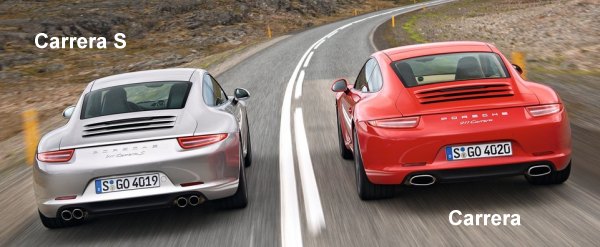 |
|
Carrera
and Carrera S can be distinguished from tailpipes.
|
|
Engines,
Transmissions and
Performance
Compare with the chassis, changes to the flat-six engines are
relatively subtle. Their basic architecture remains, as are vital
mechanisms like VarioCam Plus, resonance-type variable intake system
and direct fuel injection. An efficiency enhancement program added
on-demand oil/water pumps, automatic stop-start, regenerative
alternator and a coasting function on PDK-equipped cars. Porsche claims
fuel economy is reduced by 16 percent.
The ZF-built 7-speed PDK transmission is carried over. Now it is joined
with a manual cousin. The new 7-speed manual is derived from the PDK
and shares a third of its components. The top gear is reserved for
overdrive to save fuel.
As before, there are two versions of regular 911s – Carrera and Carrera
S. They can be distinguished from the number of tailpipes, i.e. twin
for Carrera and quad for Carrera S.
The Carrera has its engine downsized from 3.6 to 3.4 liters in order to
boost economy and further space itself from the S. This is also the
first capacity reduction since 996. Despite that, engineers still
managed to find another 5 horsepower at the top end, resulting in 350
hp at 7400 rpm. Maximum torque is kept at 288 pound-foot, although the
smaller motor takes higher rev to reach that level.
The Carrera S motor remains at 3.8 liters. Thanks to a lower
restriction intake and exhaust system, new air-flow sensors and fuel
injectors, it produces a full 400 horsepower at 7400 rpm, up from 385
hp at 6500 rpm. Max torque increases by 14 lbft and maximum rev is
lifted by 500 rpm to 7800 rpm. As expected, performance is startling.
If you opt for PDK gearbox and Sport Chrono pack (with launch control),
the Carrera S can sprint from 0-60 mph in merely 3.9 seconds, yet that
figure is on the conservative side. Flat out, the car can top 188 mph.
More telling, Porsche said the 991 Carrera S lapped Nurburgring
Nordschleife in 7:40, 14 seconds clear of its predecessor. That puts it
on the same ground as the Turbo and GT3 3.8 !
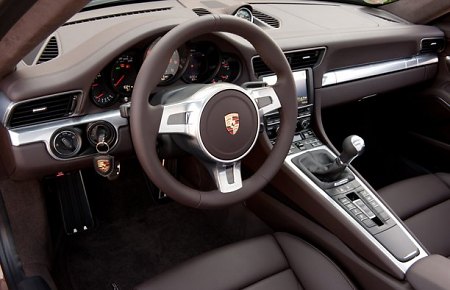 |
|
Vastly
different from 996 and 997, the cabin gets noticeably wider and a
Panamera-style center console.
|
|
On the Road
Now let's get on board. The cabin looks vastly different from 996 and
997. First of all, it gets wider, affording considerably more
shoulder room. The driver seat also gets more legroom and
headroom, so even tall guys will feel comfortable sitting all day. No
so good are the rear seats, which remain to be strictly dog seats. Once
sat on
the driver seat, you will find you are separated further apart from the
passenger by a Panamera-style center console.
Its aluminum accents and tactile switch gears feel expensive. Actually,
the whole cabin is now made of higher quality standards so that
it finally looks a match for the price tag. Meanwhile, it keeps the
strengths of the old 911 cabin, such as a superb driving position,
excellent
visibility and a traditional 5-dial instrument. One of the dials has
been converted to an LCD information display.
Both flat-six engines are creamy smooth and extremely free-revving.
Naturally, the 3.4-liter motor could feel a little sleepy at low rpm,
but it gathers rev quickly, becomes strong from 4500 rpm and even
harder beyond 6000 rpm. The 3.8-liter motor feels significantly more
potent. It pulls strongly from 3500 rpm, gets a second boost at 5000
rpm and becomes truly explosive from 6500 rpm to 7800 rpm cut-out, by
the time its metallic hollow howl is overlaid with racing-engine-like
pops and crackles on the overrun. No other six-cylinder engines could
sound so special! The PDK gearshift is crisper than before, edging
closer to the territory of Nissan GT-R but overwhelms it with
smoothness. The world's first 7-speed manual box is less good – not bad
actually, but its gearshift is just not as slick as the outgoing
6-speeder.
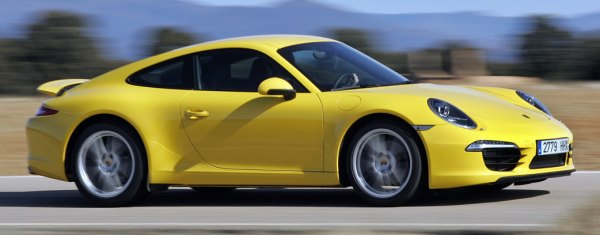 |
|
Metallic
hollow howl overlaid with pops and crackles on the overrun...
Six-cylinder engines cannot sound more special!
|
|
In normal driving, the 991 is way more refined than 997. The
new cabin
is so much better isolated from noises so that it needs a sound
symposer to conduct the engine noise into the cabin. At cruising speed,
the engine is pretty much muted. The annoying tire noise that bothered
911 for generations is largely reduced. The highly rigid,
long-wheelbase chassis and reworked suspension also deliver impressive
running refinement. Road imperfections are nicely damped and filtered,
resulting in a ride suppleness and quietness matching the best grand
tourers. Yes, its combination of GT comfort and sports car dynamics is
perhaps the biggest achievement.
Speaking of sports car dynamics, the 991 chassis has really lifted the
game. Drive as hard as you can on B-roads, you will find it corners
more like a mid-engined machine. It shows beautiful poise in cornering.
Brake dive and squat under all-out acceleration are significantly
reduced. Even though it still displays more vertical movements than the
best balanced sports cars, those movements rarely hurt its steering or
stability. You can carry huge speed into corners, abandoning the
old-school "slow in, fast out" technique that older generations 911
drivers recommended, because the nose of 991 resists understeer so much
better. Mid-corner adjustment with opposite lock and burst of throttle
becomes a basic instinct, so easy to induce and so easy to catch. That
is to say, the 991 is sharper and more confidence inspiring to drive.
Not everybody loves the electromechanical power steering though. This
is because it has eliminated the tactile information about surface
textures when it is on the straight ahead position – what else can you
expect? EPS saves energy because it does nothing on straight ahead!
Hardcore drivers prefer those kickbacks and vibration in the helm to
let them feel "engaged". However, such information is actually useless.
What matters is the feel when the wheel is steered beyond the straight
ahead, and this is what the ZF EPS excels. It provides all the messages
you need when you get into corners, and frees you from tiresome white
noises on highway. Moreover, its response, precision and weighting are
beyond criticisms. You will love its new-found lightness at cruising
speed and linear weight-up at turns. Sooner or later purists will agree
its superiority over the traditional hydraulic rack.
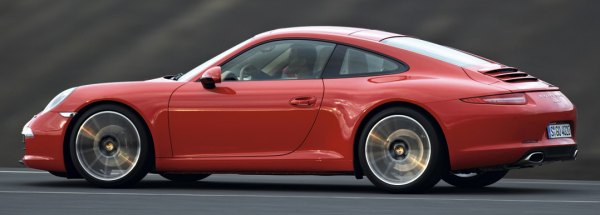 |
|
Its
combination of GT comfort and sports car dynamics is perhaps the
biggest achievement.
|
|
Against Rivals
The 991 has raised the game for its rivals to catch up. I can't think
of any cars that serve the dual-role of GT and sports car as
good as this one. Audi R8 used to be very strong in this respect, but
now it is eclipsed by the Porsche in both worlds.
Nissan GT-R should be harder to beat. It is decisively faster in both
straight line and the real world. It is roomier and cheaper too.
However, the Porsche feels sharper and more communicative in most
areas, let it be engine, chassis and most major controls. Being over
300 kg lighter, it stops better and feels more agile. Its ride is far
more comfortable and quiet. Its drivetrain has far less NVH. Its cabin
and exterior look are in a complete different class. In other words, it
trades headline numbers for quality. If you are still not convinced,
wait for the 991 Turbo.
The only rival might beat the 991 for pure driving pleasure is Lotus
Evora. It gets the best steering in the road car world and a highly
interactive chassis. Nevertheless, the rest of the car is just not up
to the class standard, let alone the level of 991.
The last rival is an in-house one – 997 GT3 RS 4.0. Yes, it is another
level for driving thrills, but isn't it too hardcore for everyday use?
Especially the deafening noise?
So let us congratulate the new 911 for
getting back to the top of the world! It shows that even after 50 years
there is still plenty of life for a rear-engined, flat-six machine!
|
Verdict:      |
Published
on 7
Apr 2014
|
All rights reserved.
|
|
911 Targa
|
|
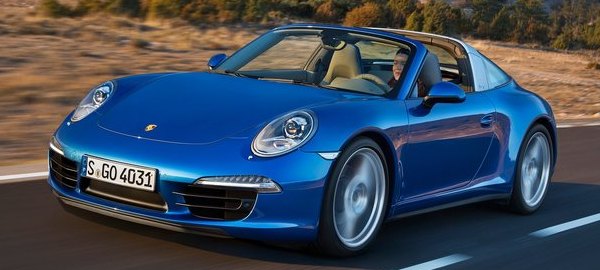 |
|
Retro-style
Targa brings old-school fun at some compromises.
|
|
The original 911 Targa was
introduced in 1967 as the first open top version of 911. In the view of
tighter safety regulations to be adopted in the US market which could
have ruled out the possibility of conventional convertibles, the Targa
adopted a prominent rollover bar behind the seats and a removable roof
panel. A wraparound rear glass window and chrome finish of the rollover
bar became its trademark. The Targa continued through the 1970s into
1980s, when it was effectively substituted by 911 Cabriolet, whose
fully opened driving environment made Targa superfluous. In the
mid-1990s, 993 revived the Targa name with a whole new interpretation.
Now it adopted fixed roof rails and a sliding panoramic glass roof,
which enabled an airy ambience if not more access to fresh air. The
formula carried over to the following 996 and 997, and in my opinion it
worked pretty well.
Surprisingly, the latest 991 Targa returns to the original 1967
concept. With a similar chrome rollover bar and wraparound rear screen,
it looks retro yet strangely attractive. However, it is not that
simple. As modern drivers would not put up with a manually operating
roof panel, so the new one is fully electric. In fact, its operation is
much like that of a coupe-cabriolet. At the press of a button, the
whole rear glass opens to the rear and tilts. At the same time, two
flaps in the Targa bar open and release the robotic arms that fold and
stow the roof panel, which is actually made of fabric materials and
magnesium frames, into the storage space behind rear seats and above
the transmission. Then the flaps and the rear glass close. This
operation looks really spectacular. Nevertheless, it takes some 19
seconds to finish, more than a typical Cabriolet, and it needs the car
to be in complete stationary. This mean, if you want to open or close
the roof behind a traffic light, you are likely to be embarrassed by
its slowness.
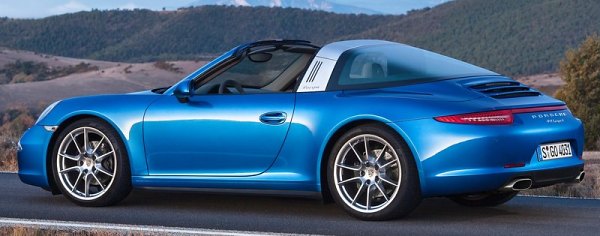 |
|
The
rear window works as an air collector thus results in strong
buffeting...
|
|
Another problem is its wind management. The rear window seems to work
as an air collector thus resulted in strong buffeting. As a result, the
cabin gets very noisy at motorway speed, even when the manual wind
deflector is raised. You won’t find the same problem on the 911
Cabriolet.
To demanding drivers, another problem is the extra weight it carries.
The new Targa mechanism adds 110 kg to the Carrera 4 or 4S on which it
is based (where the old glass-roof model added only 60 kg). It is even
heavier than the Cabriolet by 40 kg! This inevitably has a slight
burden to its performance and handling. Moreover, the mandatory
4-wheel-drive system means a further 50 kg disadvantage to the
rear-drive 911 models, and a slight initial understeer associated with
its handling. Both mean the car is slightly less sharp to drive,
although in the end the 911 is still a 911.
|
Verdict:     |
Published
on 4
Dec 2014
|
All rights reserved.
|
|
911 Carrera GTS
|
|
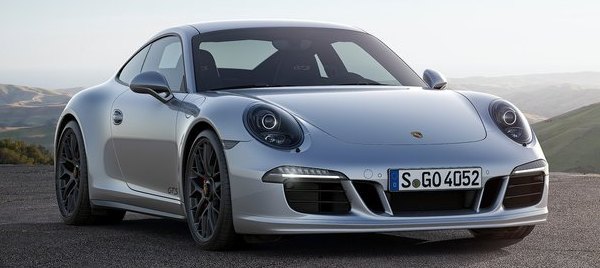 |
|
The
GTS feels tauter and keener everywhere, though there is no substitution
to GT3.
|
|
GTS has become an
indispensable model of each Porsche model line. Boxster, Cayman,
Cayenne and Panamera all get a GTS model sitting atop their naturally
aspirated models. The same goes for 911. The new 911 Carrera GTS is
based on the 3.8-liter Carrera 4S, with wider rear track than other
rear-drive 911s, though the GTS is available in the form of rear-drive,
all-wheel-drive and even Cabriolet. Its engine is tuned to produce 30
more horsepower to a total of 430 hp. You can still select between a
7-speed manual and 7-speed PDK gearbox – the former provides a slightly
higher top speed and better feel, but the latter accelerates quicker.
PASM adaptive damping, active engine mounts and Sport Chrono pack are
made standard on the GTS. The suspension is set stiffer and 10 mm
closer to the ground. Otherwise, the GTS differs from Carrera S only
cosmetically, such as a new front bumper, smoked headlamps, black
exhaust pipes and matt black wheels with center lock.
Well, we are tired of sporting the minor differences between 911
models. What we want to know is how much it differs from the lesser
Carrera S in the real world. Frankly, in normal driving the extra power
is not obvious because you need north of 7000 rpm to feel the
difference. Comparatively, the suspension change is more obvious. The
GTS feels tauter and keener everywhere. Its turn-in is more precise,
cornering attitude is closer to neutral, and the steering is more
alert. In short, the whole car feels sharper. Unquestionably this is a
better car than the Carrera S, and its small price premium actually
represents better value for money. However, there is still a sizable
gap between it and the mighty GT3, which is far faster, sharper and
more thrilling to drive.
|
Verdict:      |
Published
on 19
Dec 2015
|
All rights reserved.
|
|
911 Carrera turbo (991.2)
|
|
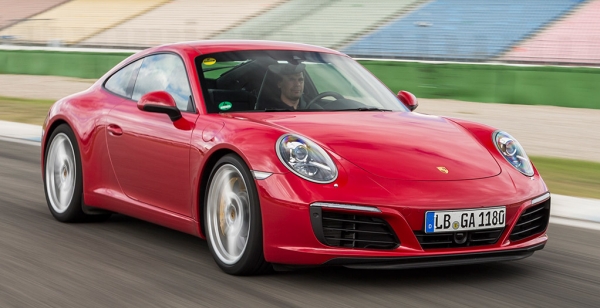 |
|
Emission
legislations forces 911 Carreras to go turbocharging. Then what
separates them from 911 Turbo?
|
|
We used to think a regular
911, namely Carrera or Carrera S, must be naturally aspirated. Why?
Because this has been the case in the past 50 years. Naturally
aspiration keeps the car straightforward and its performance and prices
accessible, so there seems to be no reason to deviate from the
established formula. Moreover, if it switches to turbocharging, what
separate it from the 911 Turbo? We can't imagine... Somehow, Weissach
engineers seem to be more flexible than we hardcore enthusiasts. Just
like how they abandoned air-cooled engine in 1997, which used to be
another golden rule we thought, they are not afraid to break away from
traditions if they see benefits for doing so.
The talks about the base 911 migrating to turbocharging has been around
for more than a year. Why do they switch to forced induction? The
answer is again
the need to lower CO2 emission to satisfy
legislation while meeting customer expectation for increased
performance. BMW already made the change in its M3/M4. The same goes
for Ferrari 488GTB and Mercedes-AMG GT – the latter is especially
successful, setting a model for Porsche to follow. Porsche would be
arrogant not to consider the change. Think about this: by downsizing
the flat-six motor to 3.0 liters and adding a pair of small
turbochargers, both the Carrera and Carrera S can produce an extra 20
horsepower and 44 pound-foot of torque while lowering fuel consumption
by 12 percent. Doesn't it sound tempting?
So here is
the second generation 991, or you may
simply call it 991.2 as Porsche internally does. Although you may spot
some tweaks
outside
and inside, by far the most substantial change has to be the now
turbocharged
engine with codename 9A2 (as opposed to the previous 9A1). Let's focus
on it.
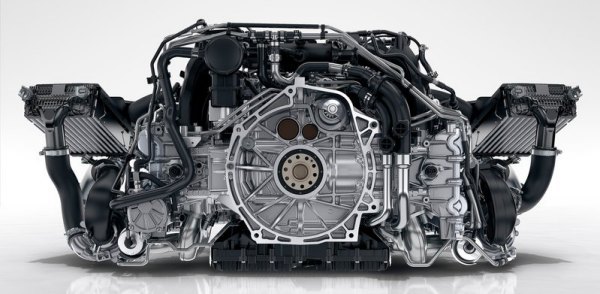 |
|
Losing
800cc but gaining two turbos means more power, and way more torque.
|
|
From technical viewpoint, 9A2 is a vastly different motor. Although it
keeps the same 118 mm bore center of the old engine – which means
plenty of space for enlargement in the future in case of need – the new
cylinder blocks are casted with a stronger and lighter kind of aluminum
alloy. The cylinder bores are now coated with iron in a new
plasma-sprayed process called Rotating Single Wire. To downsize the
engine to 2981 c.c., its bore is reduced to 91 mm, versus 97 mm of the
old 3.4-liter engine or 102 mm of the old 3.8-liter S engine.
Meanwhile, stroke is shortened slightly to 76.4 mm, but the combustion
chambers remain “oversquare” to keep a high-revving character. The
cylinder heads keep the existing dual variable cam phasing and intake
variable valve lift (Variocam Plus). Predictably, Varioram induction
manifold is abandoned as it is no longer useful on a turbocharged
engine. The direct fuel injectors have been relocated to the center and
run at higher pressure for finer atomization.
Outside, a pair of turbochargers are added together with their
intercoolers. These turbos come from BorgWarner (which acquired KKK
many
years ago) as in the case of 911 Turbo, but they lack the
latter’s sophisticated and expensive variable geometry technology.
Considering their smaller sizes, hence lower inertia and less turbo
lag, it is not really necessary to adopt VTG. The turbos pump up to 0.9
bar of boost pressure in the base Carrera to realize a maximum 370
horsepower and 332 pound-foot of torque, whereas in Carrera S the boost
is dialed up to 1.1 bar to produce 420 hp and 369 lbft. The turbos on
the S model has the same exhaust turbines but a slightly larger
compressor wheel to enable the increased boost.
Despite of a lighter block, oil pan, lubrication pump and exhaust, the
additional turbos, intercoolers and pipes etc. made the new
engine 20 kg heavier than before. On paper, 20 extra kilograms for 20
extra horsepower seem not worthwhile. In reality, however, the new
motors feel much stronger than the numbers suggested. This is because
their maximum torque is produced from as low as 1700 rpm to as high as
5000 rpm. In contrast, the old engines not only produced 44 lbft less
peak torque but they also needed to be revved to 5600
rpm. At low to mid-range the gulf between the
two is vast. It is almost like a V8 versus a V6!
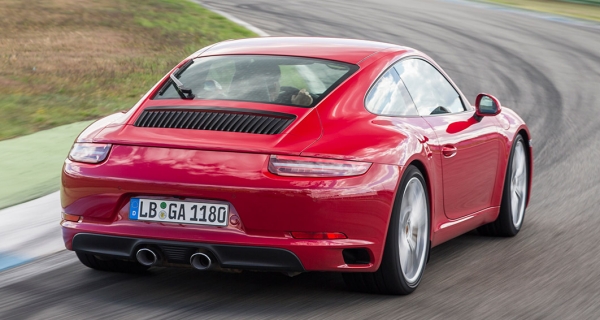 |
|
Carrera
S turbo laps Nurburgring in 7:30, some 10 seconds faster than the old
car!
|
|
With such added energy, both the Carrera and Carrera S, which are 45 to
50 kg heavier than before, take two-tenths of a second less to do
0-60 mph. Although these days I am no longer thrilled by
3-point-something-seconds as much as the first time saw it on Porsche
959, the fact that a 911 Carrera S PDK quoted 3.7 seconds is still
something worth noting, because this is supposed to be an everyday
sports
car! And its top speed is 190 mph! And it laps Nurburgring in 7:30,
some 10 seconds faster than the old car! That said, the real surprise
is the base Carrera, because with the extra torque it no longer cries
for more punch. In fact, it is faster than the old Carrera S in
Nurburgring and just a touch slower in straight line, managing the 0-60
benchmark in 4 seconds flat. For the first time ever there is no regret
to choose the cheaper car instead.
Has it lost character? Well, a little bit in terms of throttle response
and aural thrills, inevitably. There is a little turbo lag at low revs.
The exhaust note is muffled by the turbochargers, losing the volume and
the hard edge element of the old motor, but thankfully it is still a
distinctive 911 sound. With thicker torque, the new engine no longer
begs you to rev it. You can sit back and keep using higher gears to
cover ground. However, its power delivery is remarkably linear and the
power band is wide, obviously more so than the 911 Turbo. It is happy
to rev to the 7500 rpm redline, just 300 rpm shy of the old engine, and
the power tails off very slowly from the 6500 rpm peak. Such an
enthusiasm for rev is rare among turbocharged motors – Ferrari 488GTB
has it, but not BMW M3/M4. This means, on the one hand you can cruise
on highway as relaxingly as if driving a luxury car, on the other hand
you can still enjoy the fun of revving the engine should you like. The
new engine gives you more freedom.
Both transmissions are also improved. The 7-speed manual used to be a
weak point of the 991. Now its gearshift becomes shorter and quicker,
and a new twin-plate clutch brings better pedal feel and weighting. The
PDK gets a dual-mass flywheel with centrifugal pendulum to allow
smoother change at lower revs. Ratios of both gearboxes are made higher
to take advantage of the increased torque.
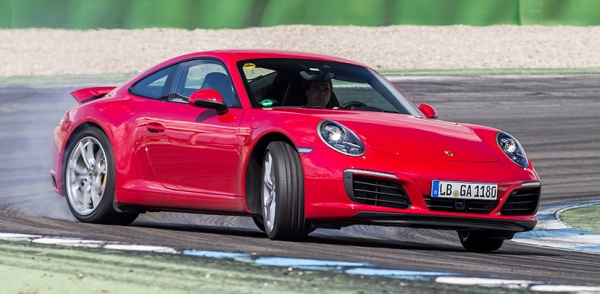 |
|
Crisper
handling, flatter ride, tighter body control, better steering feel...
the only thing going to the wrong direction is front-end styling.
|
|
The chassis is improved, too. Suspension springs, dampers and anti-roll
bars are all retuned, while PASM adaptive damping is now standard
(almost all customers opted it anyway). Ride height is lowered by 10
mm, while rear tires are widened by the same amount to cope with the
extra power. Likewise, the brakes get larger. Besides, Carrera S is
available with the option of 4-wheel steering for the first time (GT3
and Turbo got it as standard). On the road, these mods return a crisper
handling and flatter ride. Body movement becomes tighter and more
progressive in cornering. The old car’s superb balance and adjustable
attitude remain. Ditto the supple ride which makes the 911 so
accessible on mountain roads. Meanwhile, the electric power steering
gets more feelsome, thanks to the experience gained in the last 4
years.
The only thing going to the wrong direction is perhaps styling. Up
front, the larger and squarer bumper intakes have less aesthetic than
before. At the back, the engine lid switches to retro-style
longitudinal grille elements which is again less beautiful than the
last horizontal grille. Extra outlets are opened at the outer sides of
rear bumper to extract hot air from the turbocharged engine. They hurt
the purity of the old design.
However, for driving, there is still nothing in the class can beat the
911. Mercedes-AMG GT might have a madder engine, but it is not as well
balanced and controllable as the 911. Same goes for Audi R8, even
though it is now at the price range of 911 Turbo. Nissan GT-R is still
faster than the Carrera S, but it is also rougher and less comfortable
to drive everyday, let alone the build quality and badge. 911 GT3
remains a better car for keen drivers though. It reminds us, no matter
how good a turbocharged motor is, in terms of raw excitement there is
no replacement for a good naturally aspirated motor. Yes, although the
new turbocharged Carrera models are better than ever, we do miss the
sound and response of the old 3.8-liter boxer.
|
Verdict:      |
Published
on 13
Feb 2017
|
All rights reserved.
|
|
911 Carrera GTS (991.2)
|
|
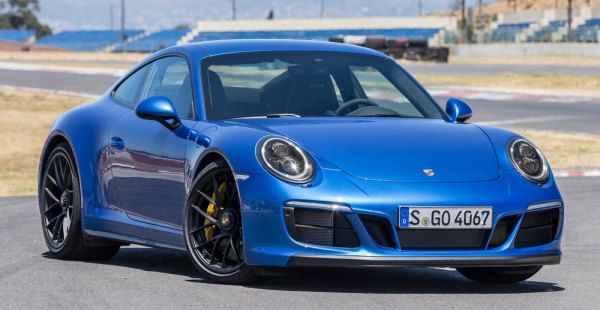
|
|
The
GTS is a Carrera S+, but how about seeing it as a mass production
959?
|
|
Interestingly,
the latest 911 Carrera GTS has many things reminiscent of the legendary
959. Its twin-turbo flat-six is approximately the same size and
produces the same 450 horsepower. It rides on electronically controlled
suspension and can be equipped with 4-wheel-drive system (in case of
Carrera 4 GTS). Both weigh about 1450 kg in standard form, and are good
for 0-60 mph in 3.5 or 3.6 seconds. The 959 is a few mph faster at the
top end, but the Carrera GTS is a few tenths quicker to 100 mph. 30
years separates them, but on
paper at least, they run neck to neck.
In some areas, the new car surpasses the classic, such as more torque
(406 vs 369 lbft), more gears (7 vs 6), the availability of PDK
twin-clutch transmission, active anti-roll bars, adaptive engine mounts
and launch control, something unimaginable back in the 1980s. The GTS
also sports optional 4-wheel-steering, so it sounds more like a
late-1980s Japanese high-tech demonstrator.
However, this is still a production Carrera, not even a
top-of-the-range 911. It is essentially a 911 Carrera S+, sitting below
the GT3 and Turbo. The creation of GTS could not be easier. Porsche
started from the wider body of Carrera 4S, equipped it with all the
popular options, i.e. PASM adaptive damping and Sports Chrono pack. The
latter includes the aforementioned adaptive engine mounts and
switchable sport exhaust. The suspension is set 10mm further lower than
Carrera S. The 3.0-liter twin-turbo engine gets slightly larger turbos
for slightly higher boost pressure, resulting in 30 extra horsepower
and 37 lbft of torque. Nothing revolutionary, but you know this is the
way Porsche upgrades its cars.
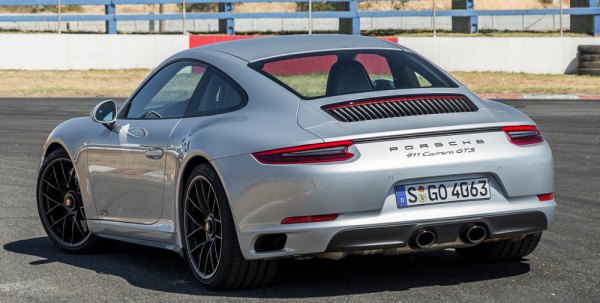
|
|
It
goes and corners like a Carrera S dialed up by a few degrees...
|
|
Predictably, the GTS goes and corners like a Carrera S dialed up by a
few degrees. The engine feels a bit stronger at mid-range without
adding much turbo lag low down or altering the 7500 rpm redline. With
sport exhaust it sounds more thrilling at push. The car is slightly
faster than the Carrera S, but not fast enough to blow your socks off.
It lapped Nurburgring Norsdschliefe in 7:26, only 4 seconds less than
the S. Unlike the GT3 RS, it is not a track special. Although the
suspension is a little firmer than the Carrera S, it remains largely
comfortable on normal roads. The steering feels more engaging, but I
suppose this is down to the experience Porsche has learnt in mastering
electrical power steering thus should be filtered back to all 911s.
We love the Carrera S, so with a little more power and poise the GTS
keeps winning our votes as the best road-going production sports car.
No, it is not as thrilling to drive as a purist GT3 or 911 R or as
astonishingly quick as McLaren 570S, but when everyday usability and
value are taken into consideration, the Carrera GTS should be the most
sensible choice. After 30 years, Porsche has finally managed to turn
959 into its mass production car.
|
Verdict:      |
|